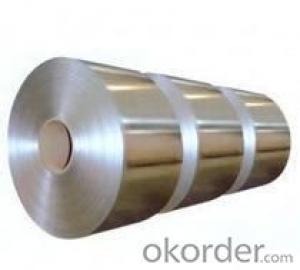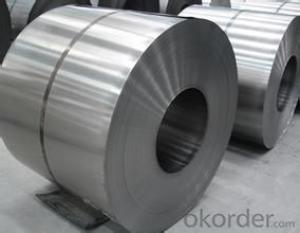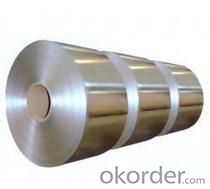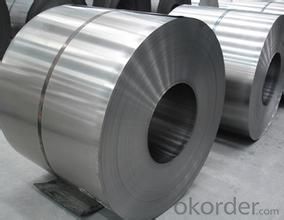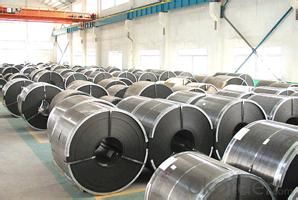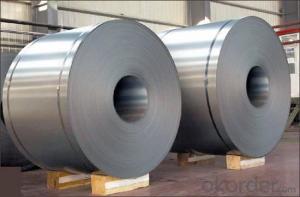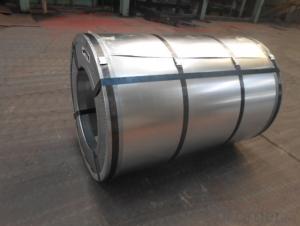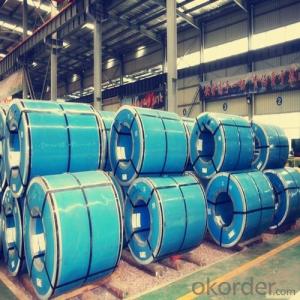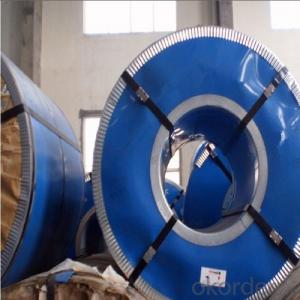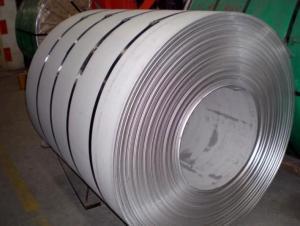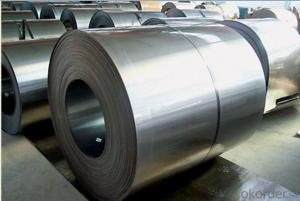excenllent cold rolled steel coil in good Quality
- Loading Port:
- Tianjin
- Payment Terms:
- TT OR LC
- Min Order Qty:
- 30 m.t.
- Supply Capability:
- 5000000 m.t./month
OKorder Service Pledge
OKorder Financial Service
You Might Also Like
Specification
The raw material of cold rolled steel coil/sheet is high quality hot rolled product, and after pickling, kinds of new technology and new process of global cold rolling production have been applied. Therefore the manufacturing, home appliance, automobile etc.
COLD ROLLED STEEL | |
Thicknenss | 0.10mm-4.00mm |
Width | 600mm-2000mm |
Sheets length | 1200-6000mm |
Coil inner diameter | 508-610mm |
Surface treatement | matt finish/bright finish,oiling/dry, bright anneal/black anneal |
Coil weight | 3-5t |
Package & Delivery
Package details: Standardseaworthy packing for international delivery.
Delivery: According to theexact quantity of your order.
Quality of the goods could be guaranteed. The finished product has a variety of excellent capabilities, such as continuous rolling, degreasing, annealing, skin pass, slitting and cut to length line etc. Along with it many rocessing capability and smooth, flat surface. It’s widely used in outdoor and interior decoration, furnishing.
Cold rolled steel is widely used in electronic production,Motorbike,Automobile,Stamping structure;Cold bent Sreel;Saw flake and etc;which is a good substitute for cold Roller and Cold plate in many field.
- Q: can anyone help me to find any webpage about lists/types of stainless steel?
- Types of stainless steel There are over 150 grades of stainless steel, of which fifteen are most common. The AISI (American Iron and Steel Institute) defines the following grades among others: - 200 Series—austenitic iron-chromium-nickel-manganese alloys - 300 Series—austenitic iron-chromium-nickel alloys Type 301—highly ductile, for formed products. Also hardens rapidly during mechanical working. Type 303—free machining version of 304 via addition of sulfur Type 304—the most common; the classic 18/8 stainless steel Type 316—Alloy addition of molybdenum to prevent specific forms of corrosion - 400 Series—ferritic and martensitic alloys.
- Q: my sister is making rolls and we have no idea what steel cut oats are. can someone please help with this?
- It does NOT look or cook like oatmeal but is made from the same grain. It takes much longer to cook since it is a whole grain, and tastes very good by the way. If you hate the slimy feel of oatmeal, this is the one to try, with all the same nutritional goodness of oatmeal. You can find it in most grocery stores in the hot cereal aisle. EDIT: you are right Mnt. Camp, steel cut is better that the regular oatmeal.
- Q: What are the different types of steel coil storage systems used during processing?
- There are various types of steel coil storage systems used during processing, including coil racks, coil cradles, coil saddles, coil blocks, and coil pads. These systems provide a safe and organized way to store steel coils, ensuring easy access, efficient handling, and minimizing the risk of damage.
- Q: What are the factors affecting the corrosion resistance of steel coils?
- There are several factors that can affect the corrosion resistance of steel coils, including the composition of the steel, the presence of impurities, the environmental conditions, the coating or protective layer applied to the steel, and the presence of any physical damage or defects on the surface of the coils.
- Q: Is steel cut really better? The nutritional profiles are nealy identical. Which one has the best flavor??Thanks!
- The biggest difference, is steel cut oats tend to be a European way, and Rolled oats are more North American, Irish and Scottish Oats tend to be steel cut, take longer to cook as the germ and whole grain is almost shredded, where with rolled oats it is process to were only a portion of the bran remains, that is why you can by Oat Bran in North America. We have instant, quick and large flake from Quaker, all cook in a matter of between 2-10 minutes, steel cut can take up to 25-30 minutes and do better in a double boiler, my mother tells a story were her grandmother would prepare it at night and let it sit on the back of the wood stove all night for breakfast the next day.
- Q: What are the surface treatments for steel coils?
- Steel coils have multiple options for surface treatments, each with a particular purpose and unique advantages. Some popular surface treatments for steel coils are: 1. Hot-dip galvanization: This technique involves submerging the steel coil in molten zinc, resulting in a protective layer of zinc coating on the surface. Galvanization provides outstanding corrosion resistance, making the steel coil suitable for outdoor use in harsh environments. 2. Electro-galvanization: By using an electrolytic process, a thin layer of zinc is deposited onto the steel coil's surface. Electro-galvanization offers good corrosion resistance, although the coating is generally thinner compared to hot-dip galvanization. 3. Pre-painting or pre-coating: Prior to being formed into final products, steel coils can be coated with paints or other coatings. This surface treatment enhances the coil's visual appeal while providing protection against corrosion, weathering, and other environmental factors. 4. Pickling and oiling: This treatment involves immersing the steel coil in an acid solution to remove oxides and scale from the surface. After pickling, the coil is typically coated with oil to prevent rust formation during storage and transportation. 5. Phosphating: Phosphating is a chemical conversion coating process that forms a phosphate layer on the steel coil's surface. This treatment improves the adhesion of subsequent coatings, such as paints or primers, while also offering some corrosion resistance. 6. Organic coatings: Steel coils can be coated with various organic materials, including epoxy, polyester, or polyurethane, to enhance their corrosion resistance and aesthetic appearance. These coatings provide a wide range of colors, textures, and finishes, making them suitable for diverse applications. It is important to consider the intended application, environmental conditions, and desired appearance when choosing a surface treatment for steel coils. Manufacturers and end-users must carefully evaluate these factors to select the most suitable surface treatment for their specific requirements.
- Q: I know that steel is generally iron with carbon and probably some other things in it, but I'm doing a research paper on architecture in Tokyo, and touching on the Tokyo Tower.The Tokyo work is larger than the Eiffel Tower by 12 meters, but lighter by 3000 tons. The only reason I can find for the difference in weight is that the Tokyo Tower is made of steel and the Eiffel Tower in made of iron, and since the Tokyo Tower is modeled after the Eiffel, there's really not a substantial difference in the amount of metal used....
- For the same volume of part, like a cubic inch, the weight is very close. If you base the comparison on strength, like a bar strong enough to hold XXX pounds, then the forged bar will be lighter, smaller still hold the weight.
- Q: How do steel coils contribute to sound insulation in buildings?
- Steel coils can contribute to sound insulation in buildings by absorbing and reducing sound vibrations. The coils act as barriers, preventing the transmission of sound waves and minimizing noise transfer between different areas of a building.
- Q: I wrote in my assignment that mild steel has a high carbon content (4%).This is why it has its strong and rigid properties.. is this correct?
- Bazza is heading in the right route yet time fogs the remember for us all. cut back small try samples off the inventory bar say pound coin thickness. warmth cherry purple and quick quench in water. The intense carbon metallic will be hardened so puzzling to scratch even as gentle scratches genuinely utilising a drill element or hacksaw blade. That warmth treatment will go away the metallic in its toughest maximum brittle state so will carry an edge yet snap like a carrot. So having hardened your merchandise it can be tempered to get rid of a few hardness and presented toughness. So the compromise is difficult adequate to carry the edge yet difficult adequate to deflect sensibly without fracture. Swot up on mood colors/warmth treatment and practice on scrap. an exciting litte exercising i have used with apprentices contained in the previous is to take an old document and anneal (melt) it so it drills or takes a said cut back genuinely then re harden it so it files back. The tang will be got here upon harder than the blade though it is the same metallic. note the tang will be bent without snapping. For practice you are able to harden the tang so it snaps common. in simple terms by how scrap chilly chisels, drill bits, files etc are in simple terms the metallic you want and recycleable by forging and warm temperature teatment. i think a Samurai second drawing close!!!!! sturdy success
- Q: What are the different methods of coil packaging for steel coils?
- There are several different methods of coil packaging for steel coils, each with its own advantages and suitability for specific applications. Some of the common methods include: 1. Strapping: This method involves using steel or plastic strapping to secure the coil and prevent it from unwinding or shifting during transportation. Strapping can be done manually or with the help of strapping machines, offering a cost-effective and reliable packaging solution. 2. Stretch wrapping: Stretch wrapping involves using a stretch film to tightly wrap the coil. The film is stretched and wrapped around the coil, providing protection against dust, moisture, and damage. This method is suitable for lightweight coils and offers good visibility of the product. 3. Steel banding: Steel banding is a robust and heavy-duty packaging method that involves using steel bands to secure the coil. This method provides high strength and durability, ensuring that the coil remains intact during transportation or storage. 4. Edge protectors: Edge protectors are used in conjunction with other packaging methods to safeguard the edges of the coil. These protectors are typically made of cardboard or plastic and provide additional support to prevent edge damage. 5. Wooden crates: For heavy or fragile steel coils, wooden crates are often used to provide maximum protection. The coils are placed inside the crate and secured with strapping or steel banding. Wooden crates offer excellent strength and stability and can be customized to fit specific coil dimensions. 6. Paper interleaving: This method involves inserting layers of paper or cardboard between individual wraps of the coil to prevent scratching or marking. Paper interleaving is commonly used when the coils are stacked together or when they have a high surface finish that needs to be protected. 7. Automated packaging systems: In larger-scale operations, automated packaging systems can be utilized. These systems are designed to handle and package coils using various methods, such as strapping, stretch wrapping, or steel banding. They offer increased efficiency and productivity while ensuring consistent and secure packaging. The choice of coil packaging method depends on factors such as the size and weight of the coil, transportation requirements, level of protection needed, and cost considerations. It is essential to select the appropriate packaging method to ensure the safe delivery of steel coils to their destination.
Send your message to us
excenllent cold rolled steel coil in good Quality
- Loading Port:
- Tianjin
- Payment Terms:
- TT OR LC
- Min Order Qty:
- 30 m.t.
- Supply Capability:
- 5000000 m.t./month
OKorder Service Pledge
OKorder Financial Service
Similar products
Hot products
Hot Searches
Related keywords
